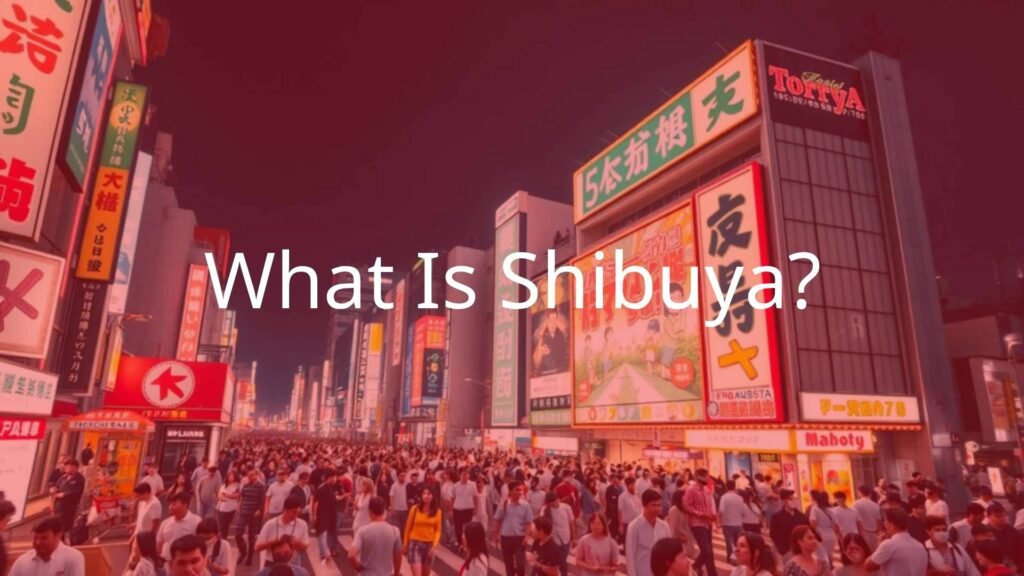Shibuya is a special ward in Tokyo, Japan, known for its lively atmosphere and central role in shopping, dining, and entertainment. The area around Shibuya Station is often what people mean when they say “Shibuya.” This station is among the world’s busiest, and the surrounding district is packed with stores, cafes, restaurants, and nightclubs, making it a favorite spot for locals and tourists. As of January 1, 2024, Shibuya Ward had about 230,609 residents in 142,443 households, all living in just 15.11 km² (5.83 sq mi). That makes the population density about 15,262 people per square kilometer. The high population and crowded businesses are part of what gives Shibuya its fast-paced, yet well-ordered vibe.
Shibuya stands for everything modern in Japan-especially when it comes to fashion and pop culture. Many worldwide trends start here, and it’s an area full of creativity, making it a small version of Tokyo itself.
Where Is Shibuya Located in Tokyo?
Shibuya sits to the west in the city of Tokyo, and it is one of the city’s 23 special wards. Its location is very central, meaning you can walk from Shibuya Station to places like Harajuku, Omotesando, or Aoyama in 20 minutes, and Daikanyama in about 15 minutes. This makes Shibuya a vital center for both travel and shopping.
Within Shibuya, you’ll find many diverse districts with their own personalities. Some of these include the trend-setting Harajuku, upmarket Ebisu, stylish Omotesando, and relaxed, green areas like Yoyogi and Sendagaya. Other well-known neighborhoods here are Daikanyama, Hiroo, Higashi, and smaller communities such as Kamiyamachō, Jinnan, Udagawachō, and Maruyamachō. This mix means that Shibuya has everything from luxury stores to quiet streets.
What Makes Shibuya Different from Other Tokyo Districts?
Shibuya is different from other parts of Tokyo because of its lively mix of people and constant buzz of activity. Where some neighborhoods like Aoyama or Harajuku may have a certain look or feel, Shibuya brings many groups together-locals, tourists, people from different backgrounds, and fans of all sorts of styles and cultures. This can be seen in its street fashion, food scene, and independent arts community.
The famous Shibuya Crossing represents the area’s unique personality. It’s the busiest crossing for people in the world, with thousands walking through at once, but everything still works smoothly. Big building projects keep updating the area’s look too, making Shibuya a place that’s always changing but still deeply linked to Tokyo’s city life.

History and Growth of Shibuya
Shibuya’s story goes back hundreds of years. Its name comes from the Shibuya clan, who settled the place in the 1160s and built a fort near today’s Konnō Hachimangu Shrine. In 1524, the Later Hōjō clan beat a branch of the Shibuya clan and took over. Over time, Shibuya changed from a small stronghold to a busy city district.
Important Moments in Shibuya’s Past
During the Edo period, an area called Maruyamachō on Dōgenzaka was a lively part of the old Oyama Road. Later, in the Meiji era, Shibuya became known for geisha houses and nightlife. The real push towards becoming a modern city area came with the building of train lines in the 1800s and early 1900s. These railways made Shibuya an important endpoint connecting Tokyo to other places.
Shibuya was officially made a ward in Tokyo city on October 1, 1932, joining with the old village of Shibuya and neighboring towns like Sendagaya. The Tokyu Toyoko Line arrived the same year, followed by other lines, and in 1947, Shibuya became an urban special ward with more independence.
A touching part of Shibuya’s story is that of Hachikō the dog, who waited at Shibuya Station every day for his deceased owner between 1923 and 1935. There’s now a statue of Hachikō at the station, and Hachikō Square is a popular meeting spot.

After World War II, Yoyogi Park in Shibuya was used by the US military as Washington Heights, then became part of the 1964 Tokyo Olympics. These changes show Shibuya’s ability to adapt over time.
Shibuya as a Center for Youth and Culture
In the 1970s, Shibuya started attracting more young people than places like Shinjuku. Big companies like Seibu and Tokyu invested in stores and shopping malls, making Shibuya a go-to place for youth shopping and entertainment. Later, in the 1990s, Shibuya was also the starting point for Shibuya-kei, a new style of Japanese pop music. Although this music craze faded, it left a big mark on Japanese culture.
Recently, Shibuya has seen large redevelopment projects. Since being named an Urban Renewal Area in 2005, major changes like tearing down and rebuilding parts of Shibuya Station, moving train lines underground, and adding new high-rise buildings like Shibuya Hikarie, Shibuya Stream, and Shibuya Scramble Square are all set to finish by 2034.

Shibuya’s Neighborhoods and Streets
Shibuya’s 15.11 km² area is a blend of busy shopping streets, quiet homes, and parks. Shibuya Station is the central point and the area shapes around it with both flat and hilly parts.
Main Areas in Shibuya
Each part of Shibuya has something different to offer. Harajuku is famous for its colorful clothes and youth crowd. Ebisu is known for its fancy restaurants and the Yebisu Garden Place. Omotesando, with tree-lined streets, has many designer stores and sleek buildings. Yoyogi stands out for its large park, and Sendagaya is a peaceful residential corner known for cultural sites. Other key neighborhoods include Daikanyama (with its hip cafes and shops), Hiroo (an area popular with foreign residents), and Higashi. The ward is further split into areas like:
- The Hatagaya Area: Sasazuka, Hatagaya, Honmachi
- The Yoyogi Area: Uehara, Ōyamachō, Nishihara, Hatsudai, Motoyoyogichō, Tomigaya, Yoyogikamizonochō
- The Sendagaya Area: Sendagaya, Jingūmae
- The Ebisu-Ōmukai Area: Kamiyamachō, Jinnan, Udagawachō, and others
- The Hikawa-Shimbashi Area: Shibuya, Higashi, Ebisu, Hiroo
Well-Known Streets and Sights
The most famous spot is Shibuya Scramble Crossing, where thousands of people cross from all directions at once. Center Gai is a walkway behind Hachikō Square, lined with shops and game arcades, and is a popular night spot. Dōgen-zaka is another lively street with shops and many nightclubs.
Omotesando is a wide street full of branded stores and stylish cafes. Cat Street is known for small, independent clothing stores. Spain-zaka is a lane with an atmosphere like a Spanish street. Other important roads are Aoyama Dōri, Komazawa Dōri (known for its yellow trees in autumn), and Nonbei-Yokochō, a narrow alley full of tiny bars.
| Street/Landmark | What’s Special |
|---|---|
| Shibuya Scramble Crossing | Busiest pedestrian crossing in the world |
| Center Gai | Youth-oriented shops and nightlife |
| Dōgen-zaka | Shops, hotels, nightclubs |
| Omotesando | High-end fashion and cafes |
| Cat Street | Unique, smaller fashion shops |
Cultural Life and Daily Living in Shibuya
Shibuya is famous for shaping what’s considered ‘cool’ in Japan. Here, trends in clothes, music, and entertainment are born and often pick up fans worldwide. Shibuya is fast and exciting, but traditional and new styles mix together smoothly.
Fashion and Pop Culture’s Center
Shibuya 109 is a symbol of youth fashion-a round building packed with boutiques aimed at teenagers. There are also stores like Shibuya Hikarie and department stores like Seibu for more grown-up tastes, while Tokyu Hands and Loft are great for creative home and office goods. Shibuya’s street scene even appears in fashion magazines around the world.

In the music world, Shibuya gave rise to ‘Shibuya-kei,’ an experimental style of pop music. Although this music craze faded, it left a big mark on Japanese culture.
Pop culture also thrives here with the Tokyo Anime Center, and anime and manga often use Shibuya as their setting. Events for fans of games and animation are frequent.
Nightlife and Things to Do at Night
When it gets dark, Shibuya becomes one of Tokyo’s main party destinations. Streets like Center Gai and Dōgen-zaka are filled with nightclubs, bars, and other attractions. Places like Womb and Club Camelot are well-known clubs, and Nonbei-Yokochō provides an old Tokyo vibe with its tiny bars. Shibuya Yokocho, an indoor street, lets visitors try different foods, enjoy live shows, or even sing at a karaoke bar.
Who Lives in Shibuya?
Shibuya is home to people from many backgrounds and cultures. The ward is open to everyone, which shows in its early support for LGBTQ+ rights (it was the first place in Japan to issue same-sex partnership certificates in 2015). After a period of population decline, Shibuya’s number of residents is growing again.
Main Things to See and Do in Shibuya
Shibuya offers lots to see-from world-famous crossings to peaceful parks and shopping. Here are some must-visit places:
- Shibuya Crossing: The busiest crosswalk on earth. You can join the crowd or watch from above at cafes like Starbucks or observation decks.
- Shibuya Scramble Square & Shibuya Sky: This tall building has shops below and a rooftop deck (Shibuya Sky) with 360° views. Entrance is 2,500 yen (2,200 yen online), open 10:00-22:30.
- Meiji Jingu Shrine: A quiet shrine surrounded by a large forest, dedicated to Emperor Meiji and Empress Shōken.
- Other Shrines and Places of Worship: Konnō Hachimangū, Tōgō Shrine, Shibuya Church, Tokyo Baptist Church, and the largest mosque in Japan, Tokyo Camii.
- Shopping: Shibuya 109 (youth fashion), Center Gai, Tokyu/Seibu/Parco/Don Quijote, and new complexes like Miyashita Park.
- Parks: Yoyogi Park for picnics or sports, Miyashita Park (shopping and rooftop sports), Shinjuku Gyo-en for gardens
- Cultural Centers: Bunkamura for concerts, National Noh Theatre and New National Theatre for classic and modern arts
- Art/Museums: Shoto Museum of Art, Watari Museum of Contemporary Art, Koga Masao Museum of Music, local movie theaters in Udagawachō and Maruyamachō
Travel and Getting Around Shibuya
Shibuya is simple to reach and navigate because of its central spot and busy network of trains, buses, and walkways. Still, Shibuya Station is huge, and a little planning helps.
Train Lines and Shibuya Station
- JR East: Yamanote Line (circles major Tokyo sites), Saikyō Line, Shōnan-Shinjuku Line
- Tokyo Metro: Ginza, Hanzōmon, Fukutoshin Lines (plus other lines nearby)
- Private Lines: Tokyu (Tōyoko, Den-en-toshi), Keio (Inokashira Line, etc.), Odakyu (Odawara Line)
Clear signs (often in English) help, and the station continues to get upgrades through 2034 to improve movement and reduce crowding.
Main Roads and Getting There
- Shuto Expressway (routes 3 and 4)
- National roads (Route 20, Route 246/Aoyama-dōri/Tamagawa-dōri)
From Haneda Airport, allow about 55 minutes by bus or 45 minutes by train. From Narita, about one hour 55 minutes by bus or one hour 40 minutes by rail.
How to Get Around Smoothly
- Learn station exits-Hachikō exit leads to the crossing and is a common meeting spot
- Use raised walkways or underground paths, which can be less crowded
- Walking is best for exploring, but quick trains link nearby districts if needed
- Allow extra time during rush hours-crowds can delay movement through the area
Shibuya’s Business Scene
Shibuya isn’t just about shopping and fun. It’s a key place for business, technology, and new ideas. Many large companies, as well as startups and creative businesses, are based here, taking advantage of good transport links and a lively community.
Main Companies and Tech Startups
- Calpis: Maker of a popular drink
- Casio: Electronics
- Mixi & Niwango: Internet and media companies
- Nihon Dempa Kogyo: Electronics manufacturing
- Tokyu Corporation: Transport and real estate giant
- CyberAgent: Advertising
- Trend Micro Japan: Computer security software
- East Japan Railway Company (JR East): Rail operator
Major tech offices like Google Japan and other companies choose Shibuya for their Japanese headquarters. Past company headquarters here have included Square Enix and Bandai Visual.
Main Office Buildings
- Shibuya Scramble Square
- Shibuya Hikarie
- Shibuya Stream (home to Google Japan)
- Shibuya Fukuras (with Tokyu Plaza and bus terminal)
- Cerulean Tower (offices and hotel)
- Omotesando Hills (high-end retail)
Schools and Education in Shibuya
Shibuya supports learning for everyone-kids, university students, and people interested in lifelong learning. The ward provides public and private schools, colleges, and library services for all ages.
Universities
- Aoyama Gakuin University
- Kokugakuin University (focus on Japanese culture and religion)
- Bunka Gakuen University (fashion and design)
- Jissen Women’s University
- University of the Sacred Heart
- Tokai University
- United Nations University
Other Schools
- Multiple public junior high and elementary schools, including Hachiyama, Harajuku Gaien, Hiroo, and more
- Private schools like Aoyama Gakuin (elementary to senior high), Fujimigaoka, Hiroo Gakuen, and International School of Sacred Heart
Libraries and Cultural Centers
- Central Library and several branch libraries
- Shibuya Cultural Center Owada (learning center, planetarium, event halls)
- Shibuya Folk and Literary Shirane Memorial Museum (local history)
Shibuya and International Relations
Shibuya welcomes people from around the world, with official partnerships and many international residents, as well as embassies and global organizations.
Partnerships
- Since 2005: Friendship city with Üsküdar in Istanbul, Turkey
- Since 2024: Sister cities with Miraflores (Lima, Peru) and Honolulu, Hawaii, USA
Embassies and International Organizations
Shibuya hosts numerous embassies, including those from the UAE, Bulgaria, Ghana, Croatia, and many others. The United Nations University is based in the ward, as well as several UN agencies and offices: ILO, UNDP, UNICEF, and more.
Common Questions about Shibuya
Is Shibuya Safe?
Shibuya, like Tokyo in general, is very safe for visitors. Crime is rare, but it’s always best to pay attention to your belongings, especially in crowds. Walking around-even late at night-is generally fine. The only challenge might be finding your way around the station or moving through thick crowds.
When Should I Visit?
| Season | What to Expect |
|---|---|
| Spring (Mar-May) | Mild weather, cherry blossoms, busy parks |
| Summer (Jun-Aug) | Hot, lively festivals, active nightlife |
| Autumn (Sep-Nov) | Cool air, colorful leaves, good for walking |
| Winter (Dec-Feb) | Cold, bright lights, fewer crowds |
What Events Happen in Shibuya?
- Seasonal Japanese festivals (parades, stalls, celebrations)
- Fashion and art events (shows, pop-up exhibitions)
- Music and nightlife (live concerts, club events)
- Food festivals (such as the Star and Sun Market in July, daily food events at Shibuya Yokocho)
- International culture festivals in Yoyogi Park (like Arabian and Brazil Festivals)
- Anime and gaming events at Shibuya Parco (Nintendo, Pokemon Center, etc.)
Check local listings for up-to-date details before you visit.
- What Is a Maiko? - July 13, 2025
- What Does Domo Arigato Mean? - July 12, 2025
- What Does Naruto Mean? - July 12, 2025









